Samsung Galaxy Note 3 Review
by Brian Klug on October 1, 2013 9:00 AM EST- Posted in
- Smartphones
- Samsung
- Mobile
- Android 4.3
- galaxy note 3
Display
One of my only issues with the Note 2 after using it for a long time was resolution. Although the move to a subpixel matrix with a full 3 subpixels per pixel on the Note 2 honestly really put most of my concerns at bay at launch, 720p started to feel limiting further on in that product’s cycle. Having more display area is great, however in Android what really matters is resolution. It was ironic having this phone with a huge display, but 720p resolution that was quickly eclipsed by devices with so much smaller displays. With the Note 3 Samsung moves to 1080p at 5.7 inches, up from the 720p at 5.5 inches in the Note 2, and 1280x800 at 5.3 inches from the original Note.
A question that immediately comes up every time we get a Samsung phone with AMOLED is first, what kind, and second what subpixel unit cell is behind it all, be it an RGB stripe or some other RG,BG alternative unit cell. In the case of the Note 3 we unsurprisingly see Samsung use the same unit cell as they did on SGS4, an offset pattern with green on one line and red and blue on another line. There’s a square blue subpixel with more area than the circular red and green subpixels as well to compensate for the difference in luminous efficiency of the material used in each subpixel type. As I’ve said in the past this isn’t PenTile (although people have started using that brand as a proxy for RG,BG alternatives) but something else entirely, but the ultimate end is still the same, two subpixels per unit pixel and not an RGB stripe.
The question for most normals then becomes – is this a big deal or can a normal human being see it? I’d argue that the subpixels on the Note 3, like the SGS4, are now small enough that they can’t be seen. I used to very picky about this, but I don’t find the new offset RG,BG pattern distracting at all on the Note 3. Subpixel size moves from just above 1 arcminute (1.006 and 1.073 for the Note and Note 2 respectively) down to 0.741 for the Note 3, making them small enough to in theory exceed human eye resolution of 1 arcminute. I won’t break out the huge table or chart, or go over all of that again, but it’s nice to see that finally be the case with the Note 3.
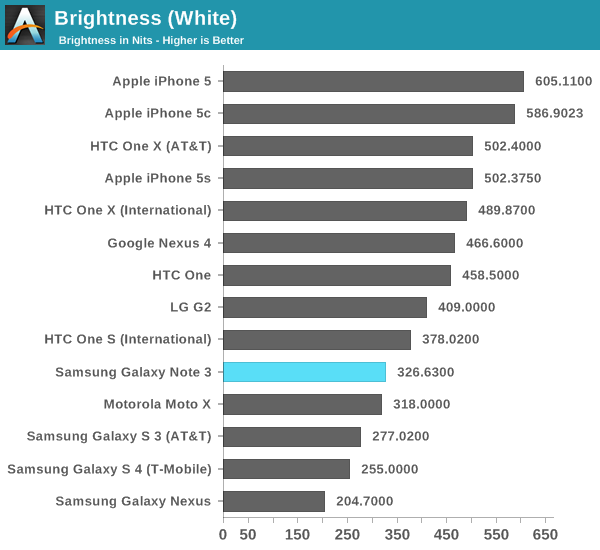
The Note 3 has the same display mode settings as we’ve seen in other generations, these mDNIe toggles allow some control over display color curves. They’re ultimately not a mitigation for Android’s lack of a real CMS and don’t completely solve the oversaturation issue that comes hand in hand with AMOLED’s different spectral curves, but they do help somewhat. These are unchanged as well from the SGS4 – Adapt Display is checked by default and will select which mode to use automatically for first party apps and a few others, but you can select between dynamic, standard, professional photo, and movie manually, which have different tunings for white point, gamut, and saturation. There’s also still the toggle for automatically adjusting screen tone depending on what’s being displayed.
Of the modes and configuration options available, I don’t doubt for a second that the most used one will be the defaults, however if you’re looking for the most sane from a color accuracy perspective it’s still Movie mode with the auto screen tone toggle unchecked. I gave Samsung the benefit of the doubt and ran all my measures in Movie mode as a result, but also took saturation measures of the other modes so you can see the difference in gamut and saturation with what you get under those.

The Standard and Dynamic modes have a ton of oversaturation, extending far beyond sRGB. In Dynamic mode we can also see some compression going on at the higher saturation levels, effectively blowing out those colors even more, with the second to last point almost on top of the last point. Pro Photo mode clamps down gamut and makes saturation a bit more linear, but has some odd other artifacts that show up. With the Movie selection made, the Note 3 display is considerably more controlled and linear, and makes a dramatic difference in how everything appears on the Note 3 during normal use. If you care about display really this is the only setting you should be using.
White point in movie mode is still bluer than I’d like at an average of just over 7100K, but in the all important Gretag Macbeth patch test, Delta-E is pretty low and puts it among iPhone 5, HTC One, and G2 territory. The results under movie mode from the Note 3 are actually nicely controlled. It still isn’t perfect, but there’s at least been an attempt made to give users that option if they don’t want garish colors that might look great on a store display but not so great if you care about matching photos you’ve taken to a display or print later, or web content between desktop and mobile.
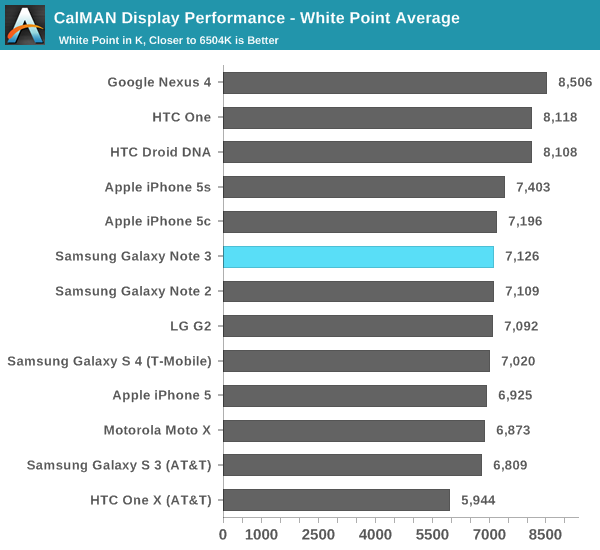
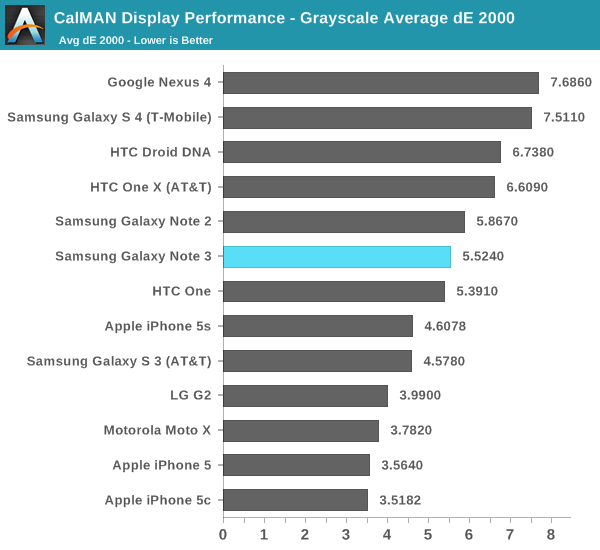
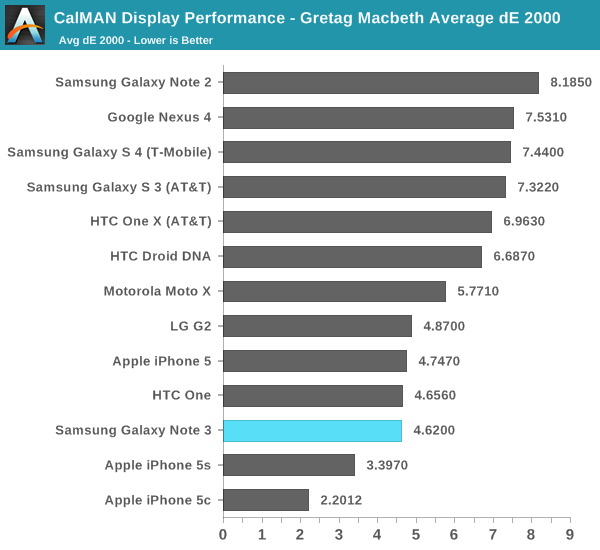
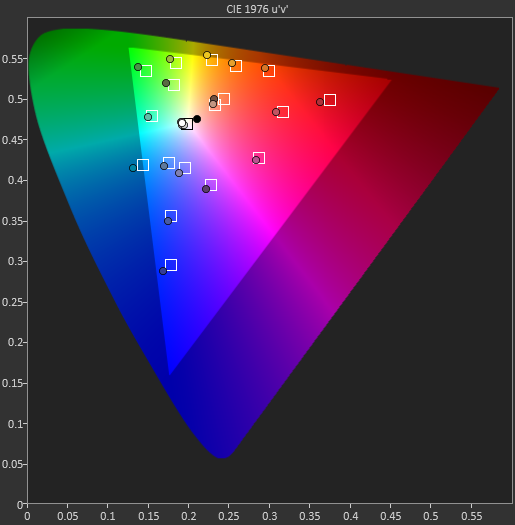
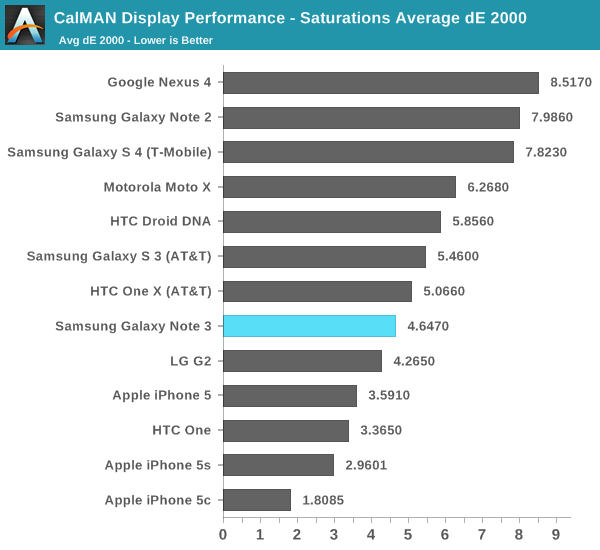



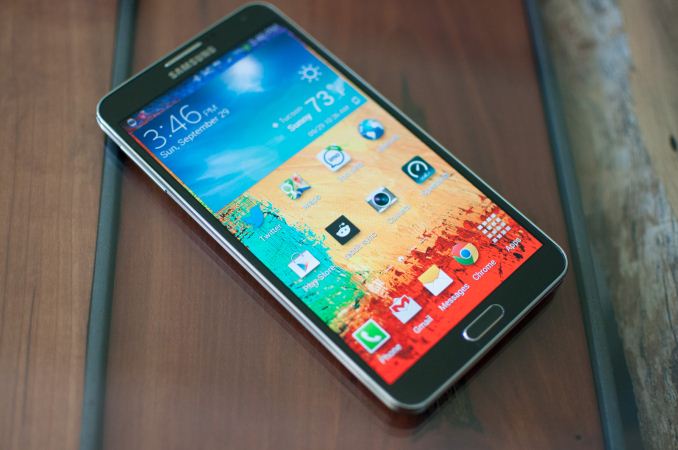
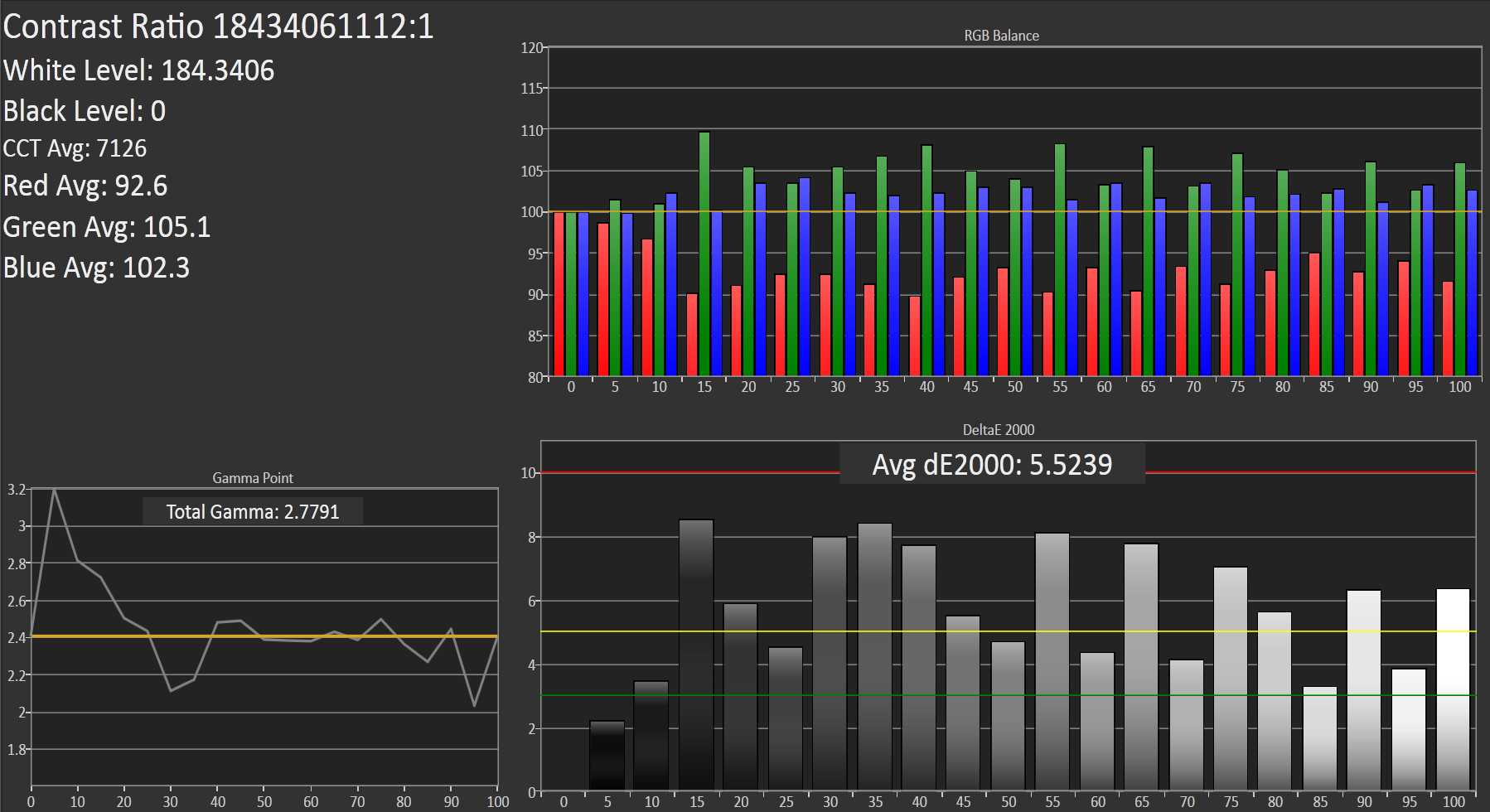








302 Comments
View All Comments
cupholder - Tuesday, October 1, 2013 - link
Why wouldn't they? They haven't been able to truly innovate since Jobs left, and no one in their right mind would actually believe at 1.3 dual core beats 2.3 quads in a whole lot.testcss - Tuesday, October 1, 2013 - link
Yeah, those 2.3 GHz Athlon X4s sure are faster than dual 1.3 GHz i7s.dugbug - Wednesday, October 2, 2013 - link
Huh no... samsung uses string matching to determine if the app is a benchmark app or not. Just create a suite of tools that use gibberish names.itpromike - Tuesday, October 1, 2013 - link
Anand, can we see the non-inflated benches for this device vs. the iPhone 5S?ciparis - Wednesday, October 2, 2013 - link
What stuck out to me was the speculation that the results were likely to be minor, while the Ars article demonstrated them to be anything but.This sort of cheating is far from new, but usually it is met with abject rejection. If you recall, when PC GPU vendors have been caught doing this, they were raked over the coals -- and it stopped, immediately. We have to hold these newcomers to competitive metrics to the same standards.
Spunjji - Tuesday, October 8, 2013 - link
Here, I shortened your comment:BLAH BLAH BLAH DIDN'T READ THE REVIEW BLAH.
Jumangi - Tuesday, October 1, 2013 - link
That's not a good enough answer Anand. Samsung and whoever else are blatantly cheating and you guys just post the false numbers in your reviews while basically saying "oh well they all do it". That's not good enough. Ars doesn't let it go at that and they show how they disabled the boosting to give real numbers. If you guys can't be bothered to do what's necessary to give your readers accurate info then why should people bother to come here?Talks - Saturday, October 12, 2013 - link
@Jumangi: "That's not a good enough answer Anand. Samsung and whoever else are blatantly cheating and you guys just post the false numbers in your reviews while basically saying "oh well they all do it". That's not good enough. Ars doesn't let it go at that and they show how they disabled the boosting to give real numbers. If you guys can't be bothered to do what's necessary to give your readers accurate info then why should people bother to come here?" oh really?!, then why are you here anyway! you, are just like the iPhone 5C that you are favoring with…, full of plastic!!! why can't you just humbly admit that by this time, Apple and its was once awesome iPhone now 5S, just like the first; and by far the truest of the true great innovator Nokia, has now being surpassed by the mighty Samsung! first in its Galaxy S3; S4; and now, the true awesome mighty Galaxy Note 3!!!akdj - Wednesday, February 5, 2014 - link
I'm not so sure I saw or read the same review as you....nor did I see the same charts. The n3 and 5s are top of the heap (I own both). The reviews of each are reflective of their performance. And these two absolutely SMOKE the S3,S4, ANY Nokia...as I believe do the year old 5--& 5c? You might wanna take another 'look'. And then think....if Apple didn't exist, would we have an S4? A Note 3? In their present form factor, speed and reliability, capability and Eco system (software and apps)? Or vice versa. No Android? We might still be playing with a 3GS and lacking LTE demand. Competition is awesome....for everyone. It keeps the innovation going....Apple's 5s is an absolutely unbelievable phone. As are the new iPad. The Note 3 is phenomenal. I. LOVE it. If half you bozos defending one company or the other would give the opposite a 'try' you might just see what the 'truth' is. So many strengths to both OSes. The flagships are mothas. Neither are anything but top shelf. The software and 'app' development community is behind both....but iOS tends to get 'some' types of apps faster, with better performance...and a significant 'choice' of whatever it is your interest is. OS updates on time. Significant resale value. Android on the flip side is amazing when it comes to 'power' user, business and professional work---tinkering, display size choice and customization....ICS completely changed the 'lag' while the hardware caught up. Both amazing systems. If justifiable, buy a pair:-). Everyone needs a 'bat-phone'!alovell83 - Tuesday, October 1, 2013 - link
I'm more disappointed in your battery charge time metric. We fully charge our phones at night, time until full isn't as important as 2 hours display and 10 hours standby, enough to get you through a night. Or how much life you can get from a 30 minute charge. That's the use-case.